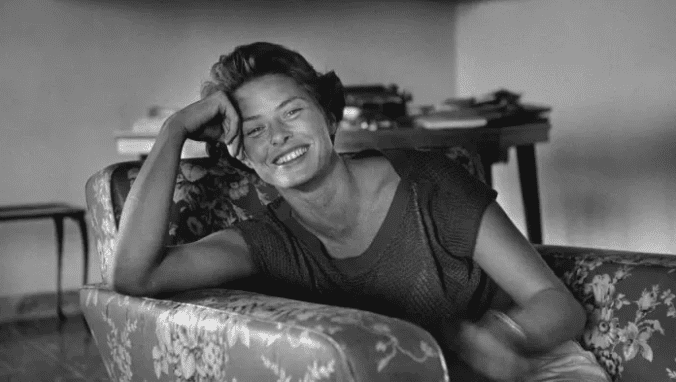She was too tall; she resisted wearing make-up because it didn’t feel natural; she refused to change her name, even if it sounded too German at just the wrong time. In fact, she thought publicity altogether was silly and humiliating — yet she would gather more of it than any movie star of her time. She got so much that it nearly buried her.
Ingrid Bergman would have been 100 last year. To celebrate that event, the Swedish film critic Stig Björkman has put together a feature-length documentary, Ingrid Bergman: In Her Own Words, which is rich in home movies, letters and diaries, and testimony from family and friends. It’s a fond tribute, telling a hectic story scarcely to be believed. And it establishes Bergman as a fierce saint in the church of acting. But the truth may be more complicated still.
Bergman believed in the storied sentiment of true love; she cherished the idea of family and being a parent; but she had a habit of falling for half the men who looked at her. She wasn’t as steady or consistent as her roles; she was a mess, if you like. More bluntly, she carried herself in that show business world like a man, taking what she wanted, having her cake and eating it. But the public loved her, men and women, and said she was an emblem of beauty and integrity.
For a few years — from Casablanca and For Whom the Bell Tolls, through Gaslight,Spellbound and Notorious — the face of Ingrid Bergman moved everyone. Calling that picture “Spellbound” on a close-up of her ardent, ravishing face was superb promotion: it declared, in 1945, This is what movies are! So when the messier truth came to light, the world turned on her with a sense of abused devotion. Bergman had been very close to a religion — she had even played a nun in The Bells of St Mary’s.
A Swedish elevator operator in the New York building where producer David Selznick had his offices was always telling Kay Brown about this marvellous Ingrid Bergman who was making pictures back home in Sweden. What a looker! What a sweet girl! What an actress! Brown was Selznick’s talent person: she had sniffed outGone With the Wind when it was still in galley. So in 1939 she went to Stockholm in the winter, found Bergman there with a young husband and a new baby and said, Surely you don’t want to give up all this, go to Los Angeles and leave your family behind on the remote chance that you might be a hit in American movies? “When do we start?” asked Bergman.
Selznick let her down. He signed her up and was very fond of her, but it was his bad luck to have fallen for Jennifer Jones (another Brown hunch), who was far less of an actress or personality. So Selznick loaned Bergman out here and there, and thus the actress who had once thought of working in Berlin became a heroine for freedom: the undecided Ilsa Lund, torn between Humphrey Bogart and Paul Henreid inCasablanca; and the crop-haired partisan who shares Gary Cooper’s sleeping bag inFor Whom the Bell Tolls. To say nothing of probably the best performance she ever gave: the haunted, hounded wife in Gaslight who regains reason and confidence, confounds her wicked husband (Charles Boyer) and gets the Oscar.
Bergman’s own husband, Petter Lindström (a dentist and later a neurosurgeon) and their daughter Pia came to the US, but the actress had that wandering eye and its pleased recipients included Spencer Tracy (they did Dr Jekyll and Mr Hydetogether); Cooper (sleeping bags have consequences); Gregory Peck (her partner inSpellbound); the harmonica genius Larry Adler; the great photographer Robert Capa; and another director, Victor Fleming, who made Joan of Arc with her.
The public knew nothing of this list, and it never appreciated that Bergman was becoming restless with the glamour and artificiality of Hollywood. After 1945, she was excited by a new realism dawning, especially in Italy, and she sent a letter to the director Roberto Rossellini — she had been captivated by his Rome, Open City. She said she knew no more Italian than “ti amo”, but would love to make a picture with him. He jumped at what he thought was his chance to get to Hollywood, and to free himself from the clinging attachment of Anna Magnani. But Bergman wanted to quit Hollywood. So it happened: she went not just to Italy, but to the volcanic island of Stromboli, where she and Rossellini worked together and began an affair. She became pregnant. Stromboli (1950) was beautiful but very odd. And those who had thought of Bergman as a saint were in convulsions of horror.
She was condemned from pulpits, in the newspapers, on the floor of the Senate and at the box office. She lost custody of Pia. She could not work in Hollywood, meaning that Rossellini had to remain in Italy. The scandal looks laced in irony now, but it was an ordeal in the late 1940s and early 1950s as Bergman and Rossellini were “condemned” to work together on under-financed pictures in a variety of languages, as she had three children with Rossellini (Isabella was one of them, born in 1952).
For years, the wake of disapproval took for granted that their movies together were awful. This is far from correct. The films are sometimes awkward and none of them did much business, yet they are being rediscovered in the warm light of history.Stromboli is a garish melodrama, but very moving. Journey to Italy (with George Sanders) and Europa 51 are masterpieces, so searching and uneasy that they were overlooked for decades. And La Paura (Fear) is one of the best movies made from a Stefan Zweig book, as well as an uncanny portrait of paranoia. These are the Bergman films that deserve being searched out, for they are the work of an actress who recognised a world that required more than Casablanca by the 1950s.
The marriage to Rossellini could not last: he was constitutionally unfaithful; she was growing older; and neither of them enjoyed the failure and rejection. So she went back to the US and in one film — the old-fashioned Anastasia — she won back the love of the public, and was awarded a second Oscar. Gradually, she became a grande dame of stage and screen, a survivor and a mother. She married again, with the utmost respectability, and returned to a throne of universal affection.
Only one thing intruded on this stability: her namesake, Ingmar Bergman, asked her if she would play the mother in a film to be called Autumn Sonata (1978), with Liv Ullmann as the daughter who has felt neglected by her mother’s carrying on her itinerant life as a famous concert pianist. Ingrid was surely smart enough to realise this scenario was a version of her own career. But she was still ambitious as an actress and incapable of refusing the challenge or the opportunity. It proved another major film, an indirect confession, and a rueful celebration of her own creative drive.
Such a life it was. The new documentary is a touch too reverent or sanitised. Family control may have been confining. But Autumn Sonata, Europa 51 and La Paura are there as valuable reminders. Bergman was a true movie star, an emotional storm centre, and then a groundbreaker, brave and foolhardy, lusty yet faithful to the great idea of being loved. We’ll always have her.




